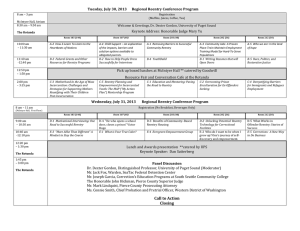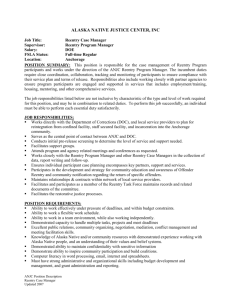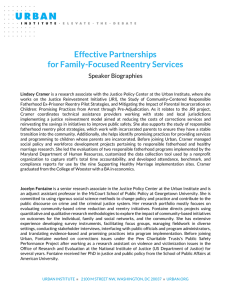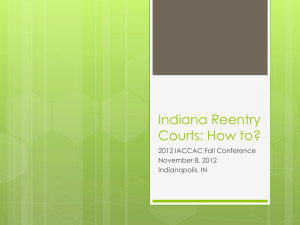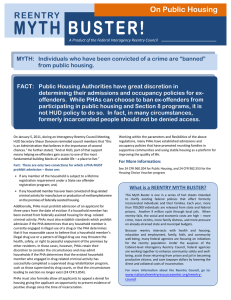IEEE C802.16m-10/1177 Project Title Date
advertisement
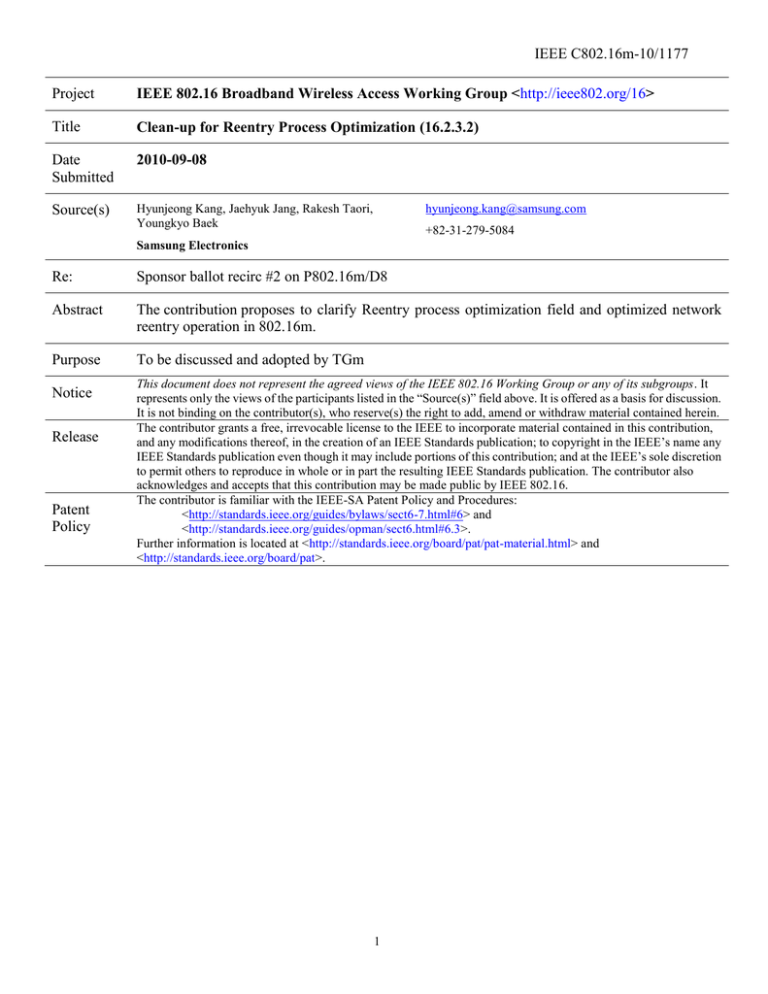
IEEE C802.16m-10/1177 Project IEEE 802.16 Broadband Wireless Access Working Group <http://ieee802.org/16> Title Clean-up for Reentry Process Optimization (16.2.3.2) Date Submitted 2010-09-08 Source(s) Hyunjeong Kang, Jaehyuk Jang, Rakesh Taori, Youngkyo Baek hyunjeong.kang@samsung.com +82-31-279-5084 Samsung Electronics Re: Sponsor ballot recirc #2 on P802.16m/D8 Abstract The contribution proposes to clarify Reentry process optimization field and optimized network reentry operation in 802.16m. Purpose To be discussed and adopted by TGm Notice Release Patent Policy This document does not represent the agreed views of the IEEE 802.16 Working Group or any of its subgroups. It represents only the views of the participants listed in the “Source(s)” field above. It is offered as a basis for discussion. It is not binding on the contributor(s), who reserve(s) the right to add, amend or withdraw material contained herein. The contributor grants a free, irrevocable license to the IEEE to incorporate material contained in this contribution, and any modifications thereof, in the creation of an IEEE Standards publication; to copyright in the IEEE’s name any IEEE Standards publication even though it may include portions of this contribution; and at the IEEE’s sole discretion to permit others to reproduce in whole or in part the resulting IEEE Standards publication. The contributor also acknowledges and accepts that this contribution may be made public by IEEE 802.16. The contributor is familiar with the IEEE-SA Patent Policy and Procedures: <http://standards.ieee.org/guides/bylaws/sect6-7.html#6> and <http://standards.ieee.org/guides/opman/sect6.html#6.3>. Further information is located at <http://standards.ieee.org/board/pat/pat-material.html> and <http://standards.ieee.org/board/pat>. 1 IEEE C802.16m-10/1177 Clean-up for Reentry Process Optimization Hyunjeong Kang, Jaehyuk Jang, Rakesh Taori, Youngkyo Baek Samsung Electronics 1. Introduction In current 16m/D8, Reentry Process Optimization field in AAI-RNG-RSP is used to indicate which MAC control message transactions can be omitted during an network reentry attempt during handover, zone switching or from idle mode. But the usage of each bit in the field is inconsistent with the operation of network reentry from handover, zone switching or idle mode. For example, Bit #2 in the field is about omitting REG-REQ/RSP transaction and higher layer protocol triggering for IP address refresh. This bit does not cover a case where REG-REQ/RSP transaction is required but IP address refresh is not performed. In addition, Bit #3 indicates ‘Full service and operational state (all static and dynamic context) transfer or sharing’ and it is used for reentry in handover as well as in idle mode. Static context and dynamic context are maintained in handover, but static context only is kept in idle mode. Therefore, this contribution proposes the cleanup of Reentry Process Optimization. It also defines an operation using the Reentry Process Optimization for network reentry in handover and idle mode. 2. Text change ------------------------------- Text Start --------------------------------------------------- [Remedy 1:] [Change Reentry Process Optimization in Table 680 (page 91, line 5) as follows:] O Reentry Process Optimization 45 Reentry process optimization bitmap indicates which MAC control message transactions may be omitted during an attempted reentry (i.e. reentry during HO (including zone switching), and reentry from idle mode) A value of 1 in the bitmap indicates that the corresponding MAC control message transaction may be omitted, while a 0 indicates that the corresponding MAC control message transaction shall be completed. The AMS shall only commence normal operation with the T-ABS after completing all the required MAC control message transactions. For each bit location, a value of 0 2 It shall be included when the AMS is attempting to perform network reentry (i.e. reentry during HO (including zone switching), and reentry from idle mode), HO or zone switch and the T-ABS wishes to identify which MAC control message transactions may be omitted.reentry IEEE C802.16m-10/1177 indicates the associated reentry MAC control messages shall be required, a value of 1 indicates the reentry MAC control message may be omitted. Bit #0: Omit AAI-SBC-REQ/ and AAI-SBC-RSP MAC control messages during reentry processing Bit #1: Omit PKM Authentication phase Bit #2: Omit AAI-REG-REQ/ and AAI-REG-RSP message and higher layer protocol triggering (for IP address refresh) during reentry processing. Bit #3: Omit higher layer protocol triggering (for IP address refresh) during reentry processing Bit #43: For the case of reentry during HO including zone switching, a 1 indicates to the AMS that the T-ABS has received the full service and operational states for static and dynamic context (including ARQ window parameters and state machines). For the case of reentry from Idle mode, a 1 indicates to the AMS that the T-ABS has received the full service and operational states for static context. If Bit #3 = 1, Full service and operational state transfer or sharing between Serving BS and Target BS (All static and dynamic context, e.g., ARQ windows, state machines. Identifies reentry process MAC control messages that may be omitted during the current HO attempt due to the availability of MS service and operational context information obtained by means that are beyond the scope of this standard, and the MS service and operational status post-HO completion. The AMS shall not enter normal operation with T-ABS until completing receiving all network reentry, MAC control message responses as indicated in HO process optimization. 3 process MAC control messages that may be omitted during the current HO attempt or idle mode reentry IEEE C802.16m-10/1177 [Remedy 2:] [Add the following text in pp. 443, line 19 in D8:] If the T-ABS evaluates a CMAC Tuple included in the AAI-RNG-REQ as valid, then the T-ABS shall reply with an AAI-RNG-RSP encrypted using AES-CCM and the T-ABS shall indicate that the PKM Authentication phase shall be omitted in the current reentry attempt using the Reentry Process Optimization bitmap. If the T-ABS evaluate a CMAC tuple as invalid, then the T-ABS shall reply with an unencrypted AAI-RNG-RSP with bit#1 in the Reentry Process Optimization bit set to 0 (i.e the PKM authentication phase shall not be omitted). If an AMS decrypts and validates the encrypted AAI-RNG-RSP, the AMS considers that the security contexts are successfully shared. [Remedy 3:] [Add the following text in pp. 315, line 53 in D8:] The network reentry procedure with the T-ABS may be optimized by T-ABS possession of AMS information obtained from S-ABS over the backbone network. The T-ABS indicates to the AMS that an optimized network reentry procedure should be carried out by setting the “Reentry Process Optimization” bitmap in Table 680. ------------------------------- Text End --------------------------------------------------- 4
